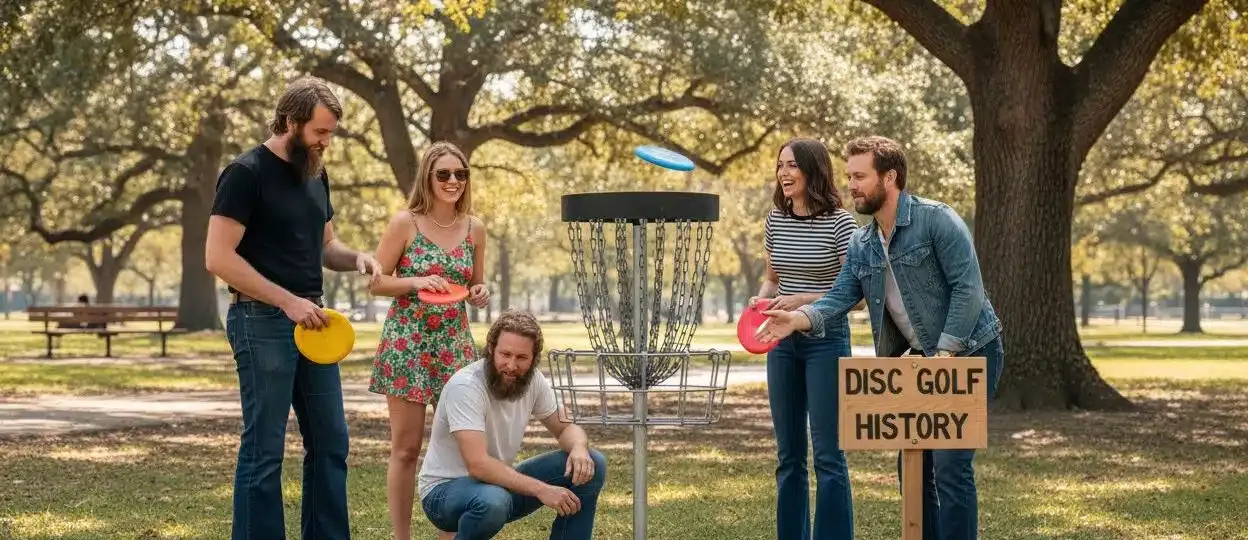
Understanding the History of Disc Golf: From Origins to Popularity
Disc golf looks like a simple twist on tossing a frisbee in the park. But dig deeper. Over 10,000 official disc golf courses now span the globe and the sport’s popularity has exploded, with millions joining the community every year. What might surprise you is how disc golf’s roots, innovations, and culture transformed it from a niche pastime into a worldwide phenomenon that’s rewriting the rules of outdoor recreation.
Table of Contents
- What Is Disc Golf And How Did It Start?
- Key Milestones In The Evolution Of Disc Golf
- The Growth Of Disc Golf: Why It Matters For Players
- Understanding Disc Golf Culture And Community
- Exploring The Future Of Disc Golf: Trends And Innovations
Quick Summary
| Takeaway | Explanation |
|---|---|
| Disc golf combines golf and disc throwing | Players aim to complete a course in fewest throws, targeting baskets instead of holes. |
| Community and accessibility drive growth | Disc golf is low-cost and open to all ages, promoting social interaction and inclusive participation. |
| Technological advances enhance equipment | New materials and designs improve disc performance, giving players better control and precision. |
| Health benefits include fitness and strategy | The sport combines physical exercise with mental challenges, improving overall well-being in an enjoyable way. |
| Disc golf culture emphasizes mentorship and inclusivity | Experienced players support newcomers, fostering a collaborative environment and community spirit. |
What is Disc Golf and How Did It Start?
Disc golf is an outdoor sport that combines elements of traditional golf with the unique dynamics of flying disc throwing. Like traditional golf, players aim to complete a course in the fewest number of throws possible, navigating through designated targets called “baskets” instead of holes. Professional disc golf organizations have established standardized rules and equipment that make this sport both challenging and engaging for players of all skill levels.
The Origins of Disc Golf
The sport’s roots can be traced back to the early 20th century, with informal disc throwing games emerging among recreational groups. However, disc golf as an organized sport truly began taking shape in the 1970s. ‘Steady’ Ed Headrick, often considered the father of disc golf, played a pivotal role in standardizing the sport by designing the first official disc golf basket and establishing the first formal course at Oak Grove Park in California in 1975.
Equipment and Gameplay Fundamentals
Disc golf requires specialized flying discs similar to but distinctly different from traditional frisbees.
![]() Players typically carry multiple discs with varying weights, shapes, and flight characteristics. The basic gameplay involves:
Players typically carry multiple discs with varying weights, shapes, and flight characteristics. The basic gameplay involves:
- Throwing a disc from a designated starting point (tee area)
- Attempting to land the disc in a metal basket with hanging chains
- Tracking the total number of throws to complete the course
The sport combines physical skill, strategic thinking, and an understanding of disc aerodynamics.
To help clarify the differences between disc types in the sport, the table below outlines the main categories of disc golf discs and their primary characteristics.
| Disc Type | Primary Use | Typical Characteristics |
|---|---|---|
| Driver | Long-distance throws | Thinner rim, designed for speed, longest flight potential |
| Midrange | Controlled approaches | Medium rim, balanced speed and stability |
| Putter | Precision near basket | Deep rim, slow speed, high accuracy and control |
Learn more about getting started with disc golf and discover why this outdoor activity has been growing in popularity across different age groups and skill levels.
Key Milestones in the Evolution of Disc Golf
The history of disc golf represents a fascinating journey of grassroots innovation and professional development, transforming from a casual recreational activity to a structured competitive sport with global recognition.
The evolution of disc golf is marked by several key milestones. The following table summarizes important periods and their major contributions to the sport.
| Period & Milestone | Key Developments |
|---|---|
| Early 1900s (Origins) | Informal disc throwing games among recreational groups |
| 1970s (Formalization) | Ed Headrick designs first basket, first formal course established |
| 1976 (Professionalization) | Professional Disc Golf Association (PDGA) founded, standardized rules created |
| Late 1970s–1980s (Technological Advances) | Manufacturers develop specialized discs, improvements in disc design and materials |
| 1990s–Present (Competitive Growth) | Expansion of tournaments, professional scene, increased accessibility and participation |
Founding and Early Standardization
The Professional Disc Golf Association emerged in 1976, marking a critical turning point in the sport’s legitimization. This organization established standardized rules, competition formats, and began creating a structured framework for disc golf as a serious athletic pursuit. Ed Headrick, already recognized for designing the first official disc golf basket, played a pivotal role in these early organizational efforts.
Technological and Equipment Advancements
Disc golf equipment evolved dramatically during the late 1970s and 1980s. Manufacturers began developing specialized discs with different flight characteristics, allowing players more nuanced control. These technological improvements included:
- Varying disc weights for different throwing styles
- Specialized designs for driving, midrange, and putting techniques
- Advanced plastic compositions improving durability and performance
Growing Competitive Landscape
By the 1990s, disc golf transitioned from a niche hobby to a more mainstream sporting activity. Discover how disc golf has expanded its competitive scene, with professional tournaments offering substantial prize money and attracting athletes from diverse backgrounds. The sport’s accessibility, low entry costs, and outdoor nature contributed significantly to its growing popularity across different age groups and skill levels.
The Growth of Disc Golf: Why It Matters for Players
Disc golf has transformed from a niche recreational activity into a vibrant, dynamic sport that offers significant personal and community benefits. Its increasing popularity reflects not just an athletic pursuit, but a holistic approach to physical fitness, social connection, and outdoor engagement.
Physical and Mental Health Benefits
Scientific research demonstrates that disc golf provides substantial health advantages. The sport combines cardiovascular exercise with strategic thinking, offering players a unique blend of physical movement and mental challenge. Players engage multiple muscle groups while navigating courses, burning calories and improving overall fitness in an enjoyable, low-impact environment.
Community and Social Dynamics
Beyond individual health benefits, disc golf has become a powerful platform for community building. The sport attracts diverse participants across age groups and skill levels, creating inclusive spaces for social interaction. Players often form local clubs, organize tournaments, and develop supportive networks that extend beyond the disc golf course. Learn more about the social benefits of disc golf, which make it more than just a competitive activity.
Accessibility and Economic Impact
Disc golf’s growth is driven by its remarkable accessibility. Compared to traditional golf, the sport requires minimal equipment investment and often uses public parks and recreational spaces. This low barrier to entry has contributed to its rapid expansion, with courses emerging in communities nationwide. Key attractions include:
- Affordable equipment costs
- Free or low-cost public course access
- Minimal age and fitness restrictions
- Opportunities for both casual and competitive play
The sport’s economic footprint continues to grow, generating revenue through equipment sales, tournament sponsorships, and local tourism centered around disc golf destinations.
Disc golf offers numerous benefits to players. The table below summarizes the main advantages discussed in the content.
| Benefit Type | Description |
|---|---|
| Physical Health | Cardiovascular exercise, muscle engagement, low-impact fitness |
| Mental Health | Strategic thinking, mental challenge, stress reduction |
| Social | Community building, inclusivity, formation of supportive networks |
| Economic | Affordable equipment, free/low-cost courses, local tourism revenue |

Understanding Disc Golf Culture and Community
Disc golf culture represents more than just a sport it is a dynamic social ecosystem characterized by passion, inclusivity, and shared experiences. The community has developed unique traditions, values, and communication styles that distinguish it from other recreational activities.
Community Engagement and Values
Scientific research reveals that disc golf communities are deeply committed to environmental stewardship and social connection. Players frequently organize volunteer events to maintain courses, promote ecological awareness, and create meaningful interactions beyond competitive play. These grassroots efforts demonstrate the community’s commitment to collective responsibility and shared enjoyment.
Collaborative Learning and Skill Development
The disc golf community is known for its supportive approach to skill development. Experienced players often mentor newcomers, sharing techniques, strategies, and equipment recommendations. Local clubs and online forums provide platforms for knowledge exchange, creating an environment where learning is collaborative and welcoming. Explore more about disc golf community dynamics, which emphasize mutual growth and encouragement.
Diversity and Inclusivity
One of the most remarkable aspects of disc golf culture is its inherent inclusivity. The sport welcomes participants across various age groups, physical abilities, and skill levels. Key characteristics of this inclusive environment include:
- Low financial barriers to entry
- Minimal physical fitness requirements
- Welcoming attitude toward beginners
- Emphasis on personal improvement over competition
- Strong sense of community and mutual respect
This inclusive nature has been crucial in driving the sport’s growth and creating a supportive, engaging recreational community that extends far beyond the disc golf course.
Exploring the Future of Disc Golf: Trends and Innovations
The disc golf landscape is evolving rapidly, driven by technological advancements, growing community engagement, and increasing recognition as a serious competitive sport. These developments are reshaping how players interact with the game and expanding its potential for broader mainstream appeal.
Technological Advancements in Equipment
Innovation in disc manufacturing continues to push the boundaries of performance. Modern disc technologies now incorporate advanced materials and aerodynamic designs that provide players with unprecedented control and precision. Manufacturers are experimenting with specialized polymers and computational modeling to create discs that offer unique flight characteristics, catering to different playing styles and skill levels.
Digital Integration and Community Expansion
Digital platforms are transforming how disc golf communities connect and compete. Mobile applications now offer course mapping, performance tracking, and virtual tournament participation. These technological tools are making the sport more accessible and engaging, particularly for younger generations who appreciate data-driven performance analysis. Discover the potential of disc golf on the global stage, where emerging technologies could play a crucial role in its international recognition.
Emerging Competitive and Social Trends
The competitive landscape of disc golf is experiencing significant transformation. Professional tournaments are becoming more sophisticated, with increased prize money and media coverage. The sport is witnessing several noteworthy trends:
- Growing international tournament circuits
- Enhanced streaming and digital broadcasting
- Increased corporate sponsorship opportunities
- Development of youth training programs
- Integration of advanced performance analytics
These developments suggest disc golf is transitioning from a recreational activity to a more structured, professionally managed sport with substantial growth potential.
Take Your Own Step in Disc Golf History
Are you inspired by the story of disc golf and curious about what it takes to join this fast-growing sport? Many beginners struggle with knowing where to start or how to choose the right discs and equipment. The article highlights how the sport welcomes all ages and skill levels and emphasizes the importance of specialized discs and equipment to boost your performance and enjoyment.

Explore top-rated discs and gear trusted by both new players and seasoned pros. Visit golfdiscs.com to discover a huge selection of high-quality disc golf products, easy guides, and tools to help you play with confidence. Don’t let confusion or lack of equipment hold you back from joining this vibrant community. Shop now and experience the joy of disc golf firsthand, or learn more about getting started with disc golf. Your journey in disc golf’s history can begin today!
Frequently Asked Questions
What is disc golf?
Disc golf is an outdoor sport that combines traditional golf elements with disc throwing, where players aim to complete a course by landing discs in designated targets called baskets.
How did disc golf originate?
Disc golf originated in the early 20th century with informal disc throwing games, but it became formally organized in the 1970s, largely due to the efforts of ‘Steady’ Ed Headrick, who designed the first official disc golf basket and established the first course in 1975.
What equipment do I need to play disc golf?
To play disc golf, you’ll need specialized flying discs, often referred to as discs, which differ from frisbees in weight and design. Players typically use multiple discs designed for driving, mid-range, and putting.
What are the social benefits of playing disc golf?
Playing disc golf fosters community engagement by bringing together people of all ages and skill levels, promoting inclusivity, social connections, and often leading to the formation of local clubs and supportive networks.
